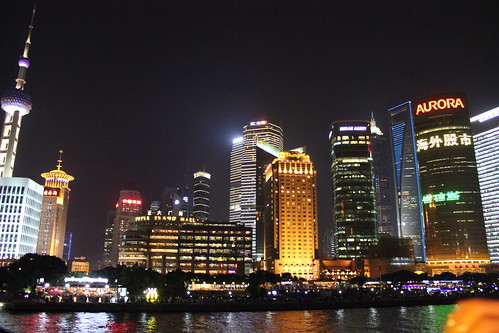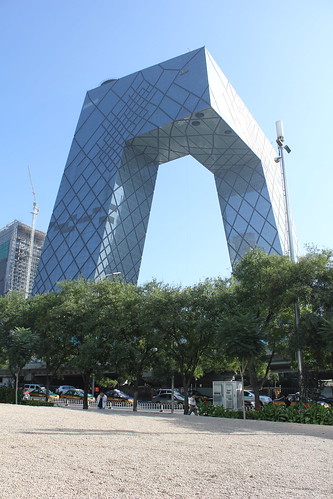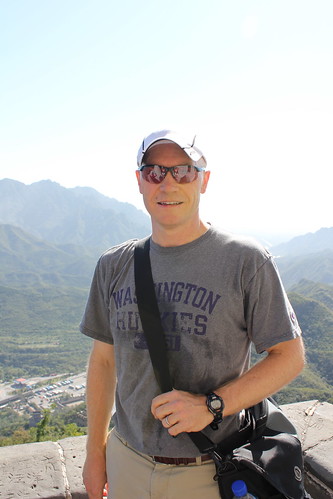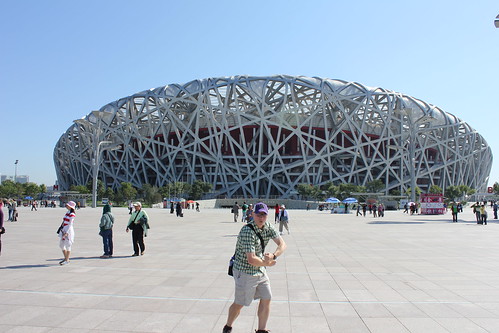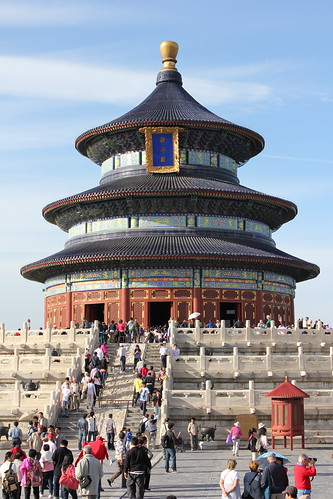A very autumnal weekend in Seattle has my recent time in China feeling even farther in the background. However, things in this rearview mirror are truly closer than they appear. I'm still spilling over thoughts of what I experienced there. I expect that will be the case for quite a while, especially as I turn some of the most relevant into part of an early chapter in my book, Pelting Out. Before I move on, consider this a quick drive-by of Shanghai thoughts. Hong Kong considerations to come tomorrow.
Anyone who talks or writes about Shanghai (including what I've put up here already) must spend some time on the crazy rate of recent growth. The idea that China's overall economy can continue to grow at 10% or thereabouts annually must be at least somewhat directly tied to Shanghai's consumption of resources and spending. I was struck by the distinct contrasts when we ventured just outside Shanghai. Two road trips in particular - to places named Yuyao and Haining - showcased the rampant consumption by the Chinese on both the retail and wholesale levels. Our bus driver got lost in Haining, which led to some harrowing turns. More importantly, I saw first hand that the whole city spills out in every direction like a busted up Mall of America. Or a scattered series of them, interspersed with older, but still not decrepit shopping locations. Eventually when we found the Haining mall we'd intended to visit in the first place, I got to see multiple generations of mall walkers doing laps on an otherwise uninspired mid-week morning. Anyone old enough to have survived Mao's Cultural Revolution and the assault that it directed toward capitalism must marvel at the 180-degree turn of China in less than half a century. I dare say China is now as much about buying things as they are about making things. And they do both very much like pros.
Our visit to Yuyao was also directed at a mall - this one comprised solely of luxury goods. Plopped in the midst of a seemingly endless low-rise collection of hutongs, this mall would have nonetheless looked right at home in any American high-end suburb. The contrast was disconcerting. I wasn't content staying within the comfy confines. So I ventured a few blocks in each direction with my camera. There - in the land of designer knock-offs and copy-cat producers - luxury was still the intended pose. Even when I saw shop keepers huddled among their goods, eating their lunches clutched up close to their faces. When I ventured just a bit farther and the theme of the shops changed abruptly, the people were nonetheless there. Sex workers staring out from behind sliding glass doors waved as I walked by. I presume there are very few Westerners strolling out there unless they had a very different sort of tour in mind. As so often proved the case in the larger cities, a solitary Western male walking invites the approach. If I had an RMB for every time I got propositioned with "lady bar?", I'd have been able to stake a place in one of the ubiquitous shopping areas I passed through. It never felt pushy or - as weird as it sounds coming from the sort of fella who would never venture into that world - inappropriate to get the casual proposition. It's just commerce - no different than someone trying to sell you a coat or a fake watch.
I left Shanghai feeling charged with an initial exposure to some of the beauty and contrasts of this part of China. I made snap judgments, as evidenced by these short recaps. Yet their obsession with appearances and the commerce of this roiling city stick out in my mind as something utterly intoxicating. Somehow I think we'll all be heading through Shanghai at sometime in the not-too-distant future. Not Shanghaied by a crimp in the old-timey sense of getting there. I'm talking free will and new commerce. To see how the Chinese will essentially be setting the economic agenda in the decades to come. What will Shanghai look like in ten years - as the world enters the DoubleTwenties (the decade length moniker I'd love to trademark already) - and how many people will lean that direction for guidance on what to buy and how to make it? That is one of the biggest questions I have as I look back. Looking forward, I'm sure such a focus will only sharpen.
For tomorrow, I'll start just after being pampered by Cathay Pacific Airways on our pseudo-international flight from Mainland China to Hong Kong. That's a big border to cross, even since the handover of Hong Kong from Great Britain to China in 1997. I still don't understand the differences. But I'll tell you this - Hong Kong rocks with verve and just slightly to the left of the expected norm, much like the Nirvana back in the day.
Anyone who talks or writes about Shanghai (including what I've put up here already) must spend some time on the crazy rate of recent growth. The idea that China's overall economy can continue to grow at 10% or thereabouts annually must be at least somewhat directly tied to Shanghai's consumption of resources and spending. I was struck by the distinct contrasts when we ventured just outside Shanghai. Two road trips in particular - to places named Yuyao and Haining - showcased the rampant consumption by the Chinese on both the retail and wholesale levels. Our bus driver got lost in Haining, which led to some harrowing turns. More importantly, I saw first hand that the whole city spills out in every direction like a busted up Mall of America. Or a scattered series of them, interspersed with older, but still not decrepit shopping locations. Eventually when we found the Haining mall we'd intended to visit in the first place, I got to see multiple generations of mall walkers doing laps on an otherwise uninspired mid-week morning. Anyone old enough to have survived Mao's Cultural Revolution and the assault that it directed toward capitalism must marvel at the 180-degree turn of China in less than half a century. I dare say China is now as much about buying things as they are about making things. And they do both very much like pros.
Our visit to Yuyao was also directed at a mall - this one comprised solely of luxury goods. Plopped in the midst of a seemingly endless low-rise collection of hutongs, this mall would have nonetheless looked right at home in any American high-end suburb. The contrast was disconcerting. I wasn't content staying within the comfy confines. So I ventured a few blocks in each direction with my camera. There - in the land of designer knock-offs and copy-cat producers - luxury was still the intended pose. Even when I saw shop keepers huddled among their goods, eating their lunches clutched up close to their faces. When I ventured just a bit farther and the theme of the shops changed abruptly, the people were nonetheless there. Sex workers staring out from behind sliding glass doors waved as I walked by. I presume there are very few Westerners strolling out there unless they had a very different sort of tour in mind. As so often proved the case in the larger cities, a solitary Western male walking invites the approach. If I had an RMB for every time I got propositioned with "lady bar?", I'd have been able to stake a place in one of the ubiquitous shopping areas I passed through. It never felt pushy or - as weird as it sounds coming from the sort of fella who would never venture into that world - inappropriate to get the casual proposition. It's just commerce - no different than someone trying to sell you a coat or a fake watch.
I left Shanghai feeling charged with an initial exposure to some of the beauty and contrasts of this part of China. I made snap judgments, as evidenced by these short recaps. Yet their obsession with appearances and the commerce of this roiling city stick out in my mind as something utterly intoxicating. Somehow I think we'll all be heading through Shanghai at sometime in the not-too-distant future. Not Shanghaied by a crimp in the old-timey sense of getting there. I'm talking free will and new commerce. To see how the Chinese will essentially be setting the economic agenda in the decades to come. What will Shanghai look like in ten years - as the world enters the DoubleTwenties (the decade length moniker I'd love to trademark already) - and how many people will lean that direction for guidance on what to buy and how to make it? That is one of the biggest questions I have as I look back. Looking forward, I'm sure such a focus will only sharpen.
For tomorrow, I'll start just after being pampered by Cathay Pacific Airways on our pseudo-international flight from Mainland China to Hong Kong. That's a big border to cross, even since the handover of Hong Kong from Great Britain to China in 1997. I still don't understand the differences. But I'll tell you this - Hong Kong rocks with verve and just slightly to the left of the expected norm, much like the Nirvana back in the day.

